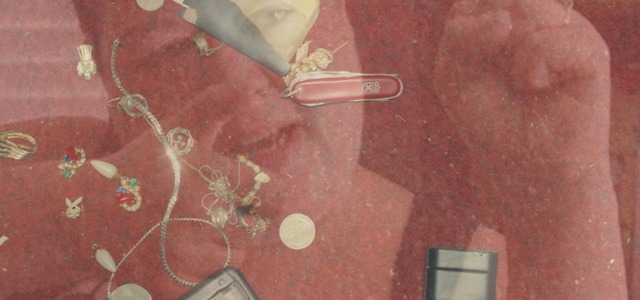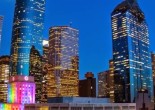
Ultimate Justice and Art About Town

Despite the blistering heat in this record-setting summer, the fall art season has kicked into high gear here in Houston. The Lawndale Art Center has an opening tonight, Texas Design Now opens tonight at the Contemporary Art Museum, the Art League has three tremendous shows on display, and the Asia Society of Texas is hosting Tibetan monks who are in the midst of creating a sand mandala to remind us that everything — even a most skillfully, painstakingly wrought manifestation of beauty — is fleeting.
Watch the live stream here (below) until you can go by, but you better hurry! The whole thing will be erased come 3:00 pm Sunday:
But let’s talk about Stephen Wilson’s “Ultimate Justice” installation at FreshArts, which closes in one week. You should swing by and check it out, and while you’re in the neighborhood, don’t miss FotoFest’s gorgeous “I Am a Camera” exhibit that documents queer lives.
Ultimate Justice
On June 12, 2024, the State of Texas executed a man named Elroy Chester for (alleged) rape and (confessed) murder. Governor Rick Perry joked about it. The audience at a Republican primary presidential debate applauded Perry. A Dutch film crew made a documentary called Killing Time about it.
Local artist Stephen Wilson was part of that film crew, and he has made an installation about it called “Ultimate Justice,” which is on view at Fresh Arts through August 28. Below is an interview I conducted with Wilson about his installation.
What was your role in the film production?
Researcher and crew assistant. I found [Elroy Chester’s] sisters in Port Arthur with little information. I had the address of a sister who had recently passed. A lady, a neighbor, happened to drive by the house while I was there and let me know where some of Elroy’s other sisters lived. They all lived around the corner.
After meeting the sisters and introducing myself, I had to make them comfortable to speak about Elroy in front of European strangers. My job was to keep them at ease during production and secretly divulge any potentially interesting tidbits to the film director. I also translated English spoken by the family for post-production. The Dutch could not understand the black/southern vernacular.
Where were you during the execution, during Elroy Chester’s final moments?
I was outside of the Walls Unit in Huntsville with the family. After some time there, I walked back with one of the sisters to the house nearby [Hospitality House] that lets family members of executed offenders stay the night before the executions. Christian folk who cook for the family and let them stay there in private rooms. you can see this house in the film.
Did you meet Chester? What was that like?
I never met Elroy.
Did you see Chester’s dead body? How was that?
I did, I took photographs of the corpse with his family. It actually seemed fairly normal, all things considered. The family was in a good place during the viewing of the body. So I was in a good place… for the time being. They go through a lot of shit, so this is just another shit they are having to sort through. The harder part for me was watching the family talk to Elroy on the phone 30 minutes before the injection.
What motivated a Dutch film crew to make a documentary about an execution in Texas?
I think the Dutch and Europeans in general regard our legal system as a complete clusterfuck, draconian at best. They are trying to get closer to this clusterfuck and report back to the mainland. They were interested in Elroy’s case in particular because of the mental health issue at stake. The director has a history of non-fiction crime-oriented films.
How was the film received in the Netherlands?
I don’t know.
The final shot in the film is one of TV news crews and (presumably) the documentary crew packing up their cameras and tripods. What does this say about the media’s role in this issue?
Another execution, another news report of an execution. the sun will rise in the morning. A passive documentation of an intricate, and extremely complex facet of state policy.
What do you mean by the print with images of Rick Perry’s head and Barnett Newman’s “Broken Obelisk” sculpture? Are they arranged in the shape of a slave ship design?
No, not in a slave ship design. If so that was unintentional. The background layer is the blueprint for modern day surveillance, known as the panopticon as designed by Jeremy Bentham in the 18th century.
This piece is a sort of collage of symbols of power, punishment, and discipline. I am trying to show what power looks like to me, here, in Texas and how it probably looks different for everyone. The broken obelisk was of course dedicated to Martin Luther King, Jr. when purchased by Mr. de Menil and brought to Houston. Another symbol of power. A positive symbol of power. My point is that all power is not bad.
What do you want audiences to take from your exhibit?
I want them to think about the insidious nature of power, societal discipline and surveillance. I use different mediums to execute the show properly, the way I understood it. I do this to show that there are many different components to this topic. It’s Ok to not be staunchly “for” or “against” this issue, the death penalty, so long as you understand the complexities presented in each case.
What can audiences get from your installation that they can’t get from the film?
A non-linear documentation of a specific state execution. An abstract presentation of crime and punishment. An interweaving of cerebral political theory and visceral imagery.




